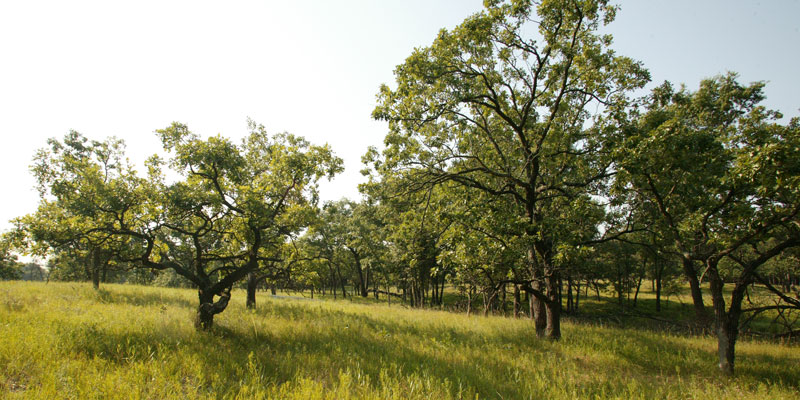Drones, planes and satellites add early detection opportunity to combat the rapid spread of oak wilt.

It sounds like something out of a tree horror movie: After spreading silently below the ground from an infected neighbor, a fungus creeps its way up through a tree’s trunk, choking off its lifeblood and eventually killing it. The rapidly spreading disease known as oak wilt is a horror for the rest of us, too: Found in 24 states, it’s spreading rapidly through Minnesota, killing forest and urban oak trees alike. In the process, we are losing not only the majestic beauty of these iconic trees, but also the many other benefits they provide, including shade, wood, pollution control, and carbon storage worth millions of dollars.
“Some 30% of the total biomass in North American forests is oak,” says Jeannine Cavender-Bares, a professor in the Department of Ecology, Evolution, and Behavior (EEB). “If we lost oaks it would be devastating. It would fundamentally change North American forests.”
Cavender-Bares, who has been studying oaks since she was a doctoral student at Harvard in the 1990s, is working to prevent that tragic outcome. With the help of a grant from the Legislative-Citizen Commission on Minnesota Resources through the Minnesota Invasive Terrestrial Plants and Pests Center, she’s leading a multi-year project aimed at detecting oak wilt early and stopping its spread. Collaborators on the grant include Rebecca Montgomery of the College of Food, Agricultural and Natural Resource Sciences; Jennifer Juzwik of the USDA Forest Service; Beth Fallon and Gerard Sapes, postdoctoral associates in EEB; Cathleen Nguyen, the team’s primary technician; and colleagues with the Minnesota Department of Natural Resources, Minnesota Extension, the University of Wisconsin and other academic institutions.
“If we lost oaks it would be devastating. It would fundamentally change North American forests.”
Oak wilt can be carried by sap beetles, but in Minnesota it more commonly spreads from one tree to another through connections between their roots underground. Control methods focus on limiting pruning to times of the year when the beetles are dormant and cutting root connections between healthy and infected trees with a vibratory plow. The only problem is, by the time it’s obvious that a tree is sick, the infection may already have spread. And the tree root connections readily grow back within six to seven years of cutting.
The main focus of the LCCMR project, which began in 2017, is to figure out how to use reflected light energy in both the visible and infrared regions of the sun’s electromagnetic spectrum to detect infection before trees are sick enough for our eyes to see signs of distress. Working at Cedar Creek Ecosystem Science Reserve and two other sites, the team is developing statistical models that can use infrared data gathered from plane, satellite, or drone to identify infections in oak stands, trees, and even individual leaves. So far they’ve had some encouraging success in accurately detecting the disease using both hand held and airborne spectroscopic instruments on planes flown by NASA and by the University of Nebraska. A study led by former postdoc Beth Fallon shows the potential for accurately diagnosing the disease using handheld devices. Postdoc Gerard Sapes is testing these approaches on field experiments. The airborne work is a highly promising area of current focus and will enable expansion to the use of satellite data.
Once they’ve refined the accuracy of the monitoring using reflected light across a wide range of wavelengths (sometimes called reflectance spectra), the researchers plan to develop a computer program that resource managers can use to apply spectral detection to spotting oak wilt in city and forest trees. Early detection, Cavender-Bares says, will make it possible to apply root cutting early and save more trees.
In addition to improving detection, the team is also testing a strategy for improving the effectiveness of root cutting. They are applying a double cut in place of the conventional single pass in hopes it will permanently, rather than temporarily, disrupt the deadly connections. The first such cuts were made in 2017, and the team will check for infection spread four and seven years later. — Mary Hoff